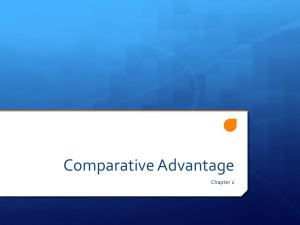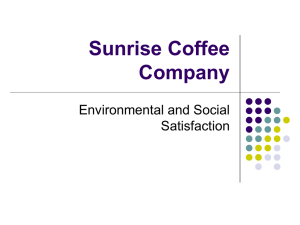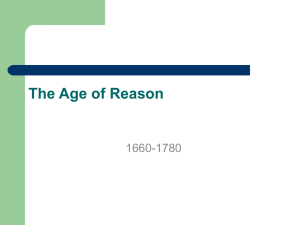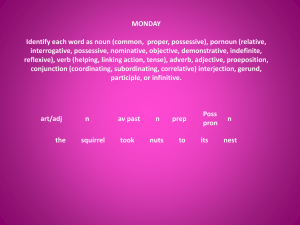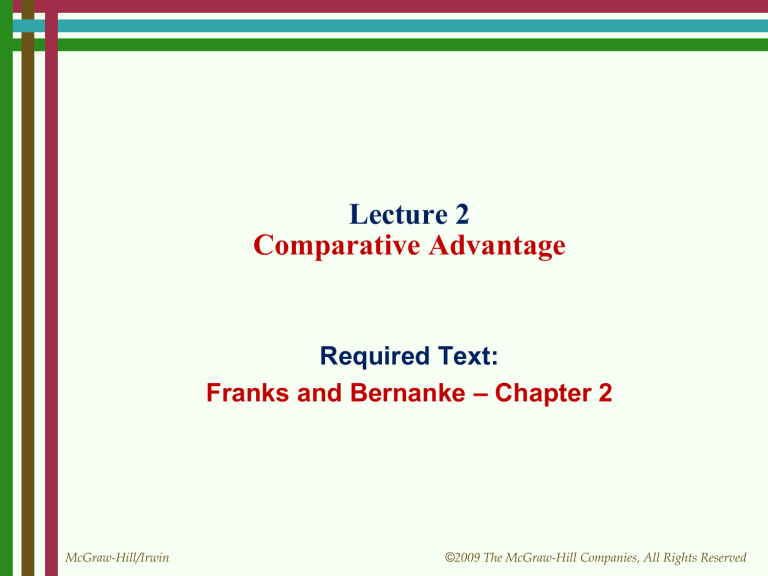
Lecture 2
Comparative Advantage
Required Text:
Franks and Bernanke – Chapter 2
McGraw-Hill/Irwin
©2009 The McGraw-Hill Companies, All Rights Reserved
Learning Objectives: Understand
1.
2.
3.
4.
The Principle of Comparative Advantage
The Principle of Increasing Opportunity Cost
Factors that shift the menu of production possibilities
The role of comparative advantage in international
trade
5. Why some jobs are more vulnerable to outsourcing
than others
LO 2- All
2-2
Do It Yourself?
Joe Jamail, a highly successful trial attorney, employs
another attorney to write his will
Writing your own will
2 hours
$10,000+
Opportunity cost of 2 hours
Hiring someone to spend 4 hours
$3,200
on your will
Making the right economic choice
Priceless
Do It Yourself only when
Opportunity cost < hired cost
LO 2 - 1
2-3
Production Advantages
Definitions
Absolute advantage
Lowest production cost
Comparative advantage
Lower opportunity cost than someone else
LO 2 - 1
2-4
The Principle of Comparative Advantage
Everyone does best when each concentrates
on the activity with the lowest opportunity cost
LO 2 - 1
2-5
The Principle of Comparative Advantage
Two parties have different opportunity costs for two
activities
Concentrate on the activities of your lowest
opportunity cost
Total value of output increases with specialization and
trade
LO 2 - 1
2-6
Comparative Advantage Example
Production Times
Web Update
Bike Repair
Paula
20 minutes
10 minutes
Beth
30 minutes
30 minutes
Paula and Beth can each update web pages and repair
bikes
Paula has an absolute advantage in both
Comparative advantage drives specialization
LO 2 - 1
2-7
Comparative Advantage Example
Production Times
Paula
Beth
Web Update
20 minutes
30 minutes
Bike Repair
10 minutes
30 minutes
Opportunity Cost
Web Update
Bike Repair
2 repairs
1 repair
0.5 update
1 update
Paula
Beth
LO 2 - 1
2-8
Comparative Advantage Example
Production Times
Paula
Beth
Web Update
20 minutes
30 minutes
Bike Repair
10 minutes
30 minutes
Hourly Output
Web Update
Bike Repair
3 updates
2 updates
6 repairs
2 repairs
Paula
Beth
LO 2 - 1
2-9
Comparative Advantage Example
Hourly Output
Web Update
Bike Repair
Paula
3 updates
6 repairs
Beth
2 updates
2 repairs
16 web updates are ordered
Paula spends half her time at each activity: 12
updates and 24 repairs
Beth produces 4 updates and 12 repairs
Total output 16 updates and 36 repairs
Specialization produces 16 updates and 48 repairs
12 more repairs for the same inputs!
LO 2 - 1
2-10
Another Example
Hourly Output
Web Update
Bike Repair
Pat
2 updates
1 repair
Barb
3 updates
3 repairs
This table shows output per hour
Principle of Comparative Advantage is the same
Look at opportunity cost per unit
Pat repairs bikes and Barb updates web pages
Opportunity Cost
LO 2 - 1
Web Update
Bike Repair
Pat
½ repair
2 updates
Barb
1 repair
1 update
2-11
0.400 Hitters
None since 1941
Not a decline in athletic ability
Specialization keeps averages lower
Pitching and fielding skills have improved
Pitchers specialize in starters, middle relievers, and
closers; right- or left-handed
batters; strike outs
Fielders play one position
Specialized coaches
Detailed analysis of hitters'
weaknesses
LO 2 - 1
2-12
Sources of Comparative Advantage
Talent
Natural resources
Cultures or societal norms
Languages
Institutions
Value placed on craftsmanship
Support for entrepreneurship
LO 2 - 1
2-13
Production Possibilities Curve
Coffee (lb/day)
A graph of the combinations of two goods that can be
produced with given resources
Definitions
24 A
Unattainable
Unattainable point
Combination
Attainable point
B
16
Inefficient
Inefficient point
Combination
Efficient point
C
8
Scarcity Principle
Give up one good to get
D
another
4
8
12
Nuts (lb/day)
LO 2 - 2
2-14
Susan's Production Possibilities
24
Coffee (lb/day)
Two goods: coffee and nuts
Work 6 hours per day
1 hour of labor
= 4 pounds of coffee OR
= 2 pounds of nuts
Graph shows options
Negative slope
16
8
A
B
C
D
4
8
12
Nuts (lb/day)
LO 2 - 2
2-15
Susan's Opportunity Cost
Marginal cost: – 8 nut
Marginal benefit: 16 coffee
Loss in nuts
Gain in coffee
Opportunity cost of 1 coffee
is ½ nut
LO 2 - 2
24
Coffee (lb/day)
Marginal cost: – 8 coffee
Marginal benefit: 4 nuts
Loss in coffee
Gain in nuts
Opportunity cost of 1 nut is
2 coffee
A
B
16
C
8
4
8
D
12
Nuts (lb/day)
2-16
Tom's Production Possibilities
Coffee (lb/day)
Work 6 hours per day
Productivity determines the slope of the PPC
1 hour of labor
A
= 4 pounds of nuts OR
12
= 2 pounds of coffee
B
Opportunity cost
8
Marginal cost: – 4 coffee
Marginal benefit: 8 nuts
4
Tom's opportunity cost of
1 coffee is 2 nuts
8
His opportunity cost of
1 nut is ½ coffee
Nuts
LO 2 - 2
C
D
16
24
(lb/day)
2-17
Tom, Meet Susan
LO 2 - 2
24
Coffee (lb/day)
PPCs show comparative
advantage
Sue's curve is steeper,
better for coffee
Tom's curve is flatter,
better for nuts
Comparative advantage
is a comparison
To get 1 coffee
Sue gives up ½ nuts
Tom gives up 2 nuts
Susan’s PPC
12
Tom’s PPC
12
Nuts (lb/day)
24
2-18
Gains from Specialization and Trade
Without trade, each person can consume
along his production possibilities curve
What you produce determines what you
consume
With trade, each person's consumption can
be greater than production
Produce according to comparative
advantage
Trade to get what you want
LO 2 - 2
2-19
Gains from Specialization and Trade
Coffee (lb/day)
24
Susan and Tom
exchange
12 nuts, 12 coffee
12
8
8 12
Nuts (lb/day)
LO 2 - 2
24
Preferred diet is half
nuts, half coffee
No trade: 8 pounds of
coffee and 8 pounds of
nuts
Total output is 32
pounds
Specialization gives
each person 12 pounds
of each good
48 total pounds
2-20
Gains from Specialization and Trade
Sue's PPC
Coffee (lb/day)
24
Trade
benefits
12
With trade
4
Tom's PPC
No trade
LO 2 - 2
4
12
Nuts (lb/day)
24
Benefits increase when
differences in opportunity
cost increase
Sue's opportunity cost of
nuts increase to 6 coffee
Tom's opportunity cost of
coffee increases to 6 nuts
No trade: 3.4 nuts and
3.4 coffee each
With trade: 12 nuts and
12 coffee each
2-21
Production Possibilities for an Economy
Coffee (1000s of lb/day)
Two goods: coffee and nuts
Multiple people
Different opportunity costs
100
95
90
A
B
Intercepts show maximum
production of one good
Some resources better at
coffe, some better at nuts
C
D
E
20
15
20
30
Nuts (1000s of lb/day)
LO 2 - 2
75
80
77
2-22
The Principle of Increasing Opportunity Cost
Coffee (1000s of lb/day)
Maximum coffee: 100,000 lb / day
Give up 5,000 pounds coffee, get 20,000 pounds of nuts
Give up another 5,000 pounds of coffee, get an 10,000
additional pounds of nuts
100
95
90
A
B
C
D
E
20
15
20
30
Nuts (1000s of lb/day)
LO 2 - 2
75
80
77
2-23
Start with resources
with lowest
opportunity cost
Then move to next
highest opportunity
cost
And still higher
opportunity cost
LO 2 - 2
Decreasing productivity
The Principle of Increasing Opportunity Cost
2-24
The Dynamic Economy
A PPC represents current choices
Changes in choices occur over time due to
More resources
Investment in capital
Population growth
Improvements in technology
More specialization: start-up and switching costs
Increases in knowledge
LO 2 - 3
2-25
Shifts in PPC
Neutral Technical
Change
Coffee
Technical Change
in Coffee
Coffee
Nuts
Nuts
Coffee
Technical Change
in Nuts
Nuts
LO 2 - 3
2-26
Some Countries Resist Specialization
Specialization is easier when
Population density passes a threshold
Markets are connected
Transportation for goods
Communications for services
Legal framework supports business
Financial markets enable start-ups
LO 2 - 4
2-27
Too Much Specialization?
Imagine this:
Your hair stylist only cuts blonde hair
An expert in tropical diseases opens a practice in a
town of 500 people in Wisconsin
Seven bookstores, each open a different day of the
week
LO 2 - 4
2-28
Comparative Advantage and International Trade
Principle of Comparative Advantage and gains from
trade apply worldwide
Potentially large gains from trading with different and
distant countries
Controversial trade
Benefits the society broadly
Costs are concentrated
Some industries
People who lose their jobs
LO 2 - 4
2-29
Outsourcing
Service work can be performed overseas
▪ Medical tourism
Customer call centers ▪ Technical writing
Medical transcription
Limits to outsourcing
Quality control
Physical presence (haircuts)
Complex communications
Understand nuance
Greatest security for workers is the ability to adapt
quickly to changing circumstances
LO 2 - 5
2-30
Comparative Advantage
Comparative
Advantage
Increasing
Opportunity
Cost
Production
Possibilities
Curve
Individual
Specialization
and Gains
from Trade
Outsourcing
Shift
PPC
Economy
LO 2- All
2-31

